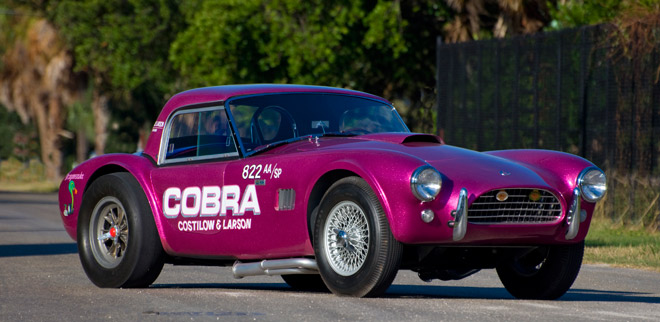SCM Analysis
Detailing
| Vehicle: | 1963 Shelby Cobra Dragonsnake roadster |
This ex-Costilow/Larson Cobra, Lot S220, sold for $901,000, including buyer’s premium, at Mecum Auction’s Kissimmee, FL, auction on January 28, 2012.
Let’s dig under all this purple metal flake and see where this result comes from.
Southern California in the early 1960s was the epicenter of drag racing culture. Shelby American offered a dream job for many hot rodders. Shelby, after being prodded to sponsor a company drag car by three of his employees, Tony Stoer, Randy Shaw and Jere Kirkpatrick, saw the marketing potential of a Cobra in drag racing.
Shelby provided a Cobra, with the stipulation that the work and racing had to be done by the employees on their own time and with minimal support from Shelby. CSX2019 was modified extensively for quarter-mile use. With Stoer at the wheel, it set the AHRA A/SSP record with a 12.81 at 108.95 mph run. The Dragonsnake package was born, and it became a factory option.
The factory produced just five Dragonsnake Cobras; Shelby American employees campaigned two of the cars, and three were built for customer orders.
Private owners prepared additional Cobras for drag racing. To date, there are three of these customer-prepared Drag Cobras that are officially recognized, including CSX2093. These are considered “Independent Drag Cobras” — not Dragonsnakes — in the eyes of the Shelby American Automobile Club. This is quite similar to the Ferrari world and factory versus privateer-prepared competition cars. In value, the factory Comp cars always trump the privateer cars, but not always in actual use.
Such is the case with CSX2093. Sold new in 1963 as a street Cobra, its first owner traded it in to Ladd Motors in Lebanon, PA, in 1964 with 5,000 miles on it.
One fast snake
Jim Costilow purchased it for $5,600 to use for road racing. Costilow soon took it to Bruce Larson — a local drag racer and GM dealership mechanic with a reputation for building winning cars — to prep 2093 for an upcoming drag race at York, PA. The Costilow/Larson drag team was formed.
The car was converted for drag racing at a reported cost of $6,000, including the 31 coats of shocking fuchsia metal-flake paint. The poor little car ran so hard trying to get out from under that paint that it was nearly unbeatable.
2093 continued to race through 1969. The car then trickled through a string of owners, returned to street duty, and was restored at various times over the years. It wasn’t until after its sale at Barrett-Jackson in 1991 that it was returned to drag race trim and fuchsia metal-flake paint. In 1998, Bruce Larson purchased 2093 and meticulously restored it back to its 1965 Costilow and Larson configuration.
Here is where we can start following the bouncing Drag Cobra CSX2093:
The auction record
In January 2007, Larson sold 2093 at Mecum’s Kissimmee auction for $1,417,500. This was a strong result, but one must remember that Mecum had also just sold CSX2019, the first factory Dragonsnake, in May 2006 for $1,601,250. Another reason why 2093 sold for such a strong price in 2007 is because Bruce Larson was selling the car.
In January 2011, the 2007 buyer consigned 2093 again to Mecum’s Kissimmee sale. It sold for $927,500. This buyer took it to Mecum’s Monterey auction in August 2011, where the car failed to sell. 2093’s next stop was Mecum Kissimmee in January 2012, where this sale took place.
So did Dragonsnake values plummet, and is $900k the new market price? Not exactly.
2007 was a high-water mark for many cars, Cobras included, and we are only now beginning to see sales approaching the same levels. After the market correction that rolled in with the global economic collapse of 2008, today’s buyers are being especially cautious.
And as it pertains to our subject car, in the Cobra world there has been much debate about it being called a “Dragonsnake.” While it is indeed a documented, highly successful Drag Cobra with unquestionable provenance, and was campaigned in period as a “Dragonsnake,” it is in fact an Independent Drag Cobra and not a Factory Dragonsnake. And, as we see with any competition car, this is a critical distinction. There is a huge value difference between a factory-prepared car and an owner- or privateer team-prepared car.
Hypothetically, take two 1965 GT350s. One is a 1-of-36 Factory R model and the other is a street GT350 converted to a race car when new — and now carries a fantastic race history. The factory R Model should bring twice what the privateer car would, which is exactly how I would peg the value difference between 2093 today versus the best factory Dragonsnake.
Now, let’s approach 2093 from another angle. Let’s say it was never converted to a drag car and was presented today as it was originally delivered — a nice, stock 289 worm-and-sector steering Street Cobra. I’d peg its value in this configuration at around $450k, which means the drag racing history added a solid 100% bump.
So, using either method of valuation, I’d say this result for CSX2093 at auction was absolutely spot-on. With just eight recognized Drag Cobras in existence, they are a fascinating part of the competition Cobra lore. But following Shelby’s death in May, the market has started to fluctuate. Where it goes from here remains to be seen.
Now let’s hope 2093’s new owner gets this car aimed down a 1,320-foot strip soon and see if it can still try to outrun that color. I would love to be there, and I’m sure Bruce Larson would as well.
